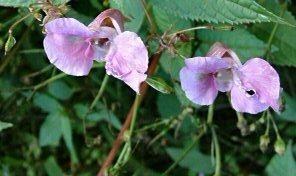Himalayan balsam
(Impatiens taprobanica)

Description
Impatiens glandulifera, Himalayan balsam, is a large annual plant native to the Himalayas. Via human introduction it is now present across much of the Northern Hemisphere and is considered an invasive species in many areas. Uprooting or cutting the plants is an effective means of control. In Europe, Himalayan balsam is included since 2017 in the list of Invasive Alien Species of Union concern (the Union list). This implies that this species cannot be imported, cultivated, transported, commercialized, planted, or intentionally released into the environment in the whole of the European Union. It typically grows to 1 to 2 m (3.3 to 6.6 ft) high, with a soft green or red-tinged stem, and lanceolate leaves 5 to 23 cm (2.0 to 9.1 in) long. The crushed foliage has a strong musty smell. Below the leaf stems the plant has glands that produce a sticky, sweet-smelling, and edible nectar. The flowers are pink, with a hooded shape, 3 to 4 cm (1+1⁄4 to 1+1⁄2 in) tall and 2 cm (3⁄4 in) broad; the flower shape has been compared to a policeman's helmet. After flowering between June and October, the plant forms seed pods 2 to 3 cm (3⁄4 to 1+1⁄4 in) long and 8 mm broad (1⁄4 in), which explode when disturbed, scattering the seeds up to 7 metres (23 feet). The green seed pods, seeds, young leaves and shoots are all edible. The flowers can be turned into a jam or parfait. The plant was rated in first place for per day nectar production per flower in a UK plants survey conducted by the AgriLand project which is supported by the UK Insect Pollinators Initiative. (However, when number of flowers per floral unit, flower abundance, and phenology were taken into account, it dropped out of the top ten for most nectar per unit cover per year, as did all plants that placed in the top ten for per-day nectar production per flower, with the exception of Common Comfrey, Symphytum officinale.) Himalayan balsam is native to the Himalayas, specifically to the areas between Kashmir and Uttarakhand. In its native range it is usually found in altitudes between 2000 and 2500 m above sea level, although it has been reported in up to 4000 m above sea level. In Europe the plant was first introduced into the United Kingdom by Dr John Forbes Royle, professor of medicine at King's College, London who became Superintendent of the Botanic Gardens, Saharanpur, India. It has now become naturalized and widespread across riverbanks. Presently it can be found almost everywhere across the continent.
Taxonomic tree:







